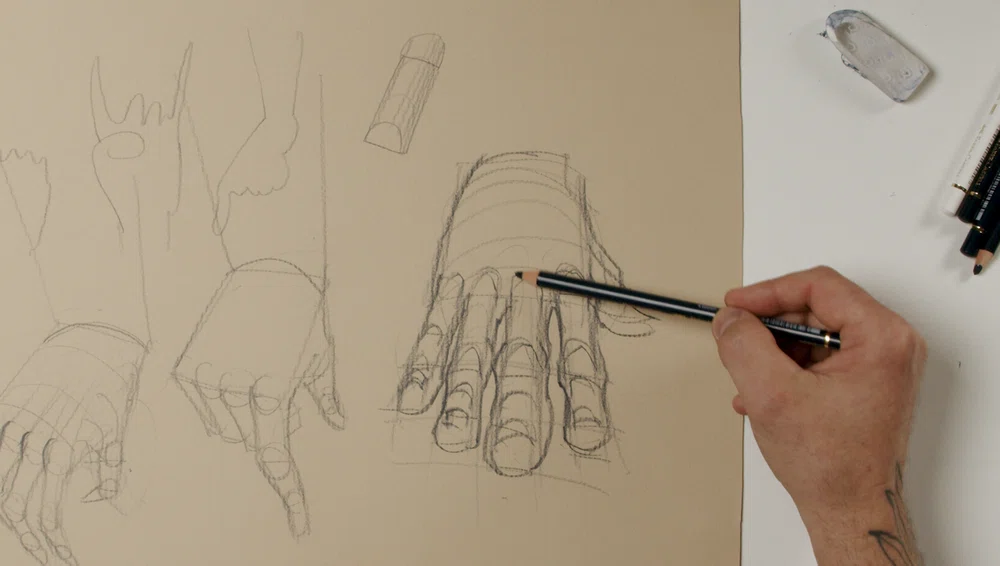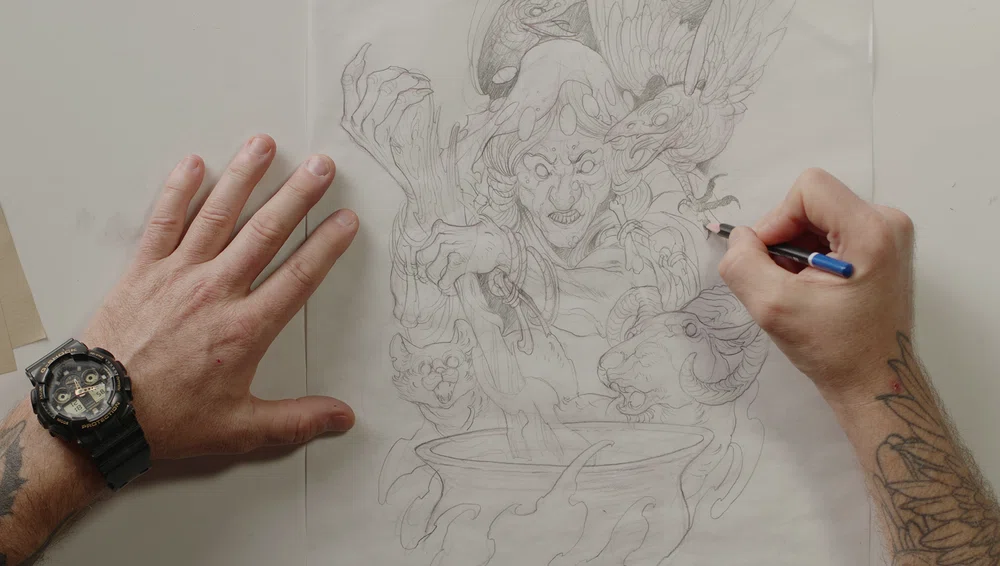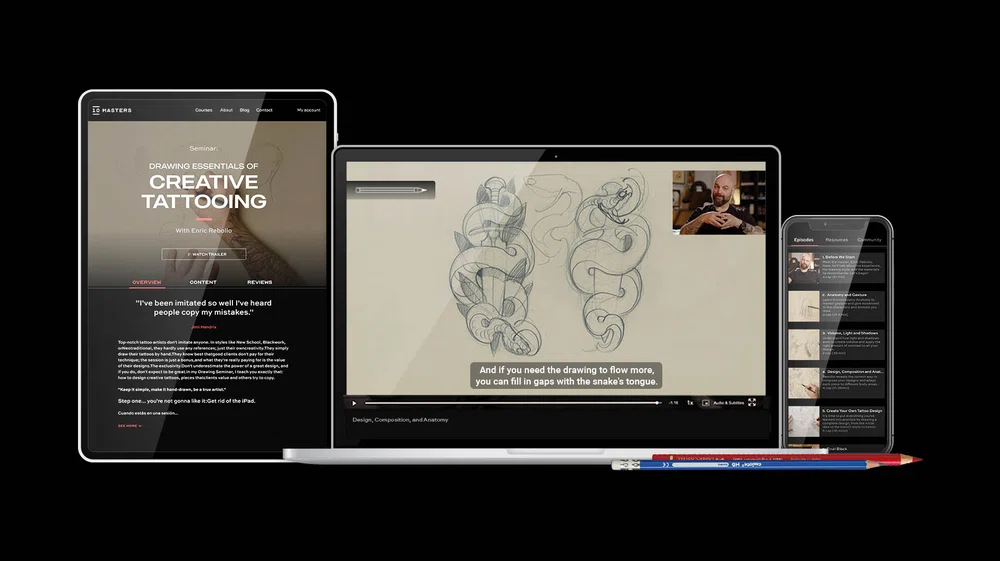Benefits of knowing how to draw for tattooing
How drawing helps you stand out as a tattoo artist
10 June 2024
Drawing might be one of the most questioned skills for tattooing; there are always those who believe that there's no need to draw to be able to tattoo.
Which is debatable, especially in cases where it technically doesn’t require it, as in blackout tattoos, phrases, or “borrowed” designs (something only true professionals avoid at all costs).
In fact, if we go back to the classic tattoo era, where tools were way more limited and iconic flash tattoos were in the lead, we can see that many artists got by without the need to draw, even tattooing others' designs.
But that was another time, the profession as we know it today was just starting out, and we couldn’t even imagine how much the tattoo market would evolve.
Still, to this day, drawing remains at the center of the debate, as many tattoo artists claim it’s not necessary for tattooing. So, who should we listen to? What benefits does knowing how to draw for tattooing bring? Are there any downsides?
In this battle, there can only be one winner... Knowing how to draw or not knowing how to draw?
The bell rings, let the fight begin!
BENEFITS OF DRAWING AS A TATTOO PROFESSIONAL
Offering Unique and Creative Designs
A large part of the clientele prefers designs that are original or at least modified in some way.
Whether it’s to bring a concept they have in mind to life or to add your personal input to a reference, drawing is key to offering what they're looking for. And when you’re good at this, you have better chances to visualize and exchange ideas, which makes it easier to interpret and illustrate the design.
Although there will always be someone who asks you to tattoo the exact design they found on Pinterest, it’s up to you to reject it or propose a solution that aligns with your values.
In short, drawing is not only useful for offering exclusive and personalized designs, but it also sparks your creativity, allows you to explore different techniques, and helps you stand out with your own personal style.
Creating More Aesthetic and Attractive Compositions

Understanding how light and shadow behave is fundamental to achieving designs with depth, and you can only learn this through drawing.
Pencil and paper are perfect for trying out everything in terms of effects, shapes, proportions, and overall composition. And while tattooing is a whole different story, as it’s not the same to drawing on paper as it is to "drawing" on skin, it’s always the first step to mastering the techniques that make up a design.
When we talk about design, we don’t just mean a nice, harmonious aesthetic, but also full functionality and adaptability. As, let’s not forget, our canvas is the human body, and the tattoo must flow with it.
In the end, drawing should be understood as a whole, where unity and balance are the core of an aesthetic design.
So, if we took design as the essential foundation of a tattoo, skipping this part would be just like an architect who can’t create blueprints or a mathematician who can’t understand formulas.
Solving Common Problems During the Session
It would be great if everything went perfectly during a tattoo session, but that’s far from reality.
From theory to practice, there’s always a gulf of unforeseen events. When tattooing, many factors influence your work, and it’s up to you to be as prepared as possible to tackle any issues.
To name one of the most common... how to act if at mid-session you lose your reference lines? There are many solutions for when the stencil fades, but having your drawing skills well-polished can be a real lifesaver. Especially when the situation doesn’t lend itself to relocating the stencil.
But fear not! If you have confidence and are good at drawing, this dilemma won’t be a problem for you.
All the same, knowing how to draw prepares you to make changes on the fly if they help the design, improvise details you hadn’t considered before, or simply play more with what your creative skill offers.
Having a Steadier hand and Gaining Confidence

In addition to the above, nothing better for your steadiness than practicing drawing, as it helps develop the muscle and achieve firmer strokes.
Having a steady hand when holding the machine to tattoo crisp and precise lines is essential for achieving effective and attractive results.
If you’ve never practiced drawing, and you just jump into tattooing, there’s a high chance you’ll feel like a kid holding a pencil for the first time; as the machine has a particular shape and weight that you need to get used to. So, if it’s already complex to hold it, imagine if you can't draw...
In the end, confidence is also key when tattooing, and the best ally for that is practice, both on paper and skin.
Attracting More Clients with Your Portfolio
A book or portfolio is your best business card; it’s the first impression people get of your work. So, having it well-organized and displayed is crucial to catching the eye of potential clients.
Knowing how to draw plays a significant role in creating an impressive and effective tattoo portfolio, as it leaves room for showcasing all your skills, both technical and creative.
But not only that, it’s also the perfect opportunity to demonstrate your artistic potential and express your signature style, that which makes you stand out from other artists.
Overall, exhibiting your own creations shows your versatility, adaptability, and talent. Something almost impossible if you don’t know how to draw.
TATTOOING WITHOUT KNOWING HOW TO DRAW?
Wait, did you really expect it to be beneficial to tattoo without drawing skills? 👀 'Cause we couldn’t think of any reason why you shouldn’t learn it!
The winner of this duel is clear... "Knowing how to draw" has knocked out "Not knowing how to draw."
HOW TO MAKE THE MOST OUT OF THE TATTOO PROFESSION

There are many valid ways to practice this craft, and what’s better or worse varies depending on what you aim to achieve with it.
Is it possible to tattoo without knowing how to draw? Yes. Is it the most convenient? Depends on whether you want it to be a hobby or your way of making a living from what you love.
If you want to be a true Tattoo Artist, then, no doubt; learning how to draw should be a top priority. It not only prepares you better for sessions, but it’s also a great tool to stand out and attract clients. In short, to get the most out of tattooing.
In the end, what most clients crave is a good design. Something original that can only be delivered through drawing skills...
Just look at your role models; all those pieces that got you into this art, every single one of those tattoos that blew your mind, started as a simple line on paper.
Think about it for a sec, rarely (or never) does a client ask you to tattoo a technique; they ask for a design.
Having good technique is important, but having the ability to create is game-changing... at least if you want to avoid tattooing feeling like just another mechanical job where you don’t contribute anything unique and risk throwing in the towel due to lack of motivation.
CREATE ORIGINAL TATTOOS FROM THE IDEA TO THE STENCIL
If you’ve been following us for a while, you already know we defend drawing tooth and nail.
It’s no coincidence that all the Masters in our courses are expert drawers. It’s literally what has positioned them best as references; it’s the reason why many have even copied them, and why their clients always prefer them over others.
It’s their differential value, which people are willing to pay more for to have that exclusivity; to walk down the street proudly showing off their tattoo without having to live the embarrassing moment of crossing someone on the subway with the same design…
Isn’t that what every artist craves? For their art to be unique? For their work to make them feel fulfilled?
If just reading this excites you, imagine achieving it 🤯.
Actually, there’s no need to imagine it because we’ve created something special to help you make it a reality. A proposal you won’t see anywhere else that can take you from “I don’t know how to stand out” to “finally they ask me for what I like to tattoo”, even if your technique isn’t the best.
And no; we haven't lost our minds.
If a tattoo drawing teacher with 25 years of experience who’s also worked as an illustrator and comic book artist can’t teach you to draw better, then who can?
Seminar: Drawing Essentials of Creative Tattooing, with Rebollo.
Learn to Design Tattoos so Original that Inspire Copycats
